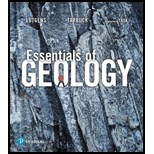
The match for each of the processes of a, b and c with the given zones depending upon the dominant processes operating in the different parts of a river system.
Answer to Problem 1GST
The dominant processes that match with the zones are as follows:
Zone #1: a. sediment production.
Zone #2: c. sediment transportation.
Zone #3: b. sediment deposition.
Explanation of Solution
Streams are channels of water that flow on the surface of the earth. Streams flow in different networks and finally join the surface water in the sea.
Zone #1: a. sediment production. This is a zone in which most of the sediments are originated or developed mainly due to erosion and by mass wasting, and overland flow. This zone is mainly located in the headwater region of a river system.
Zone #2: c. sediment transportation. Here, the sediments from the production zone are transported through the drainage network in a balanced state of erosion and accumulated along the banks of stream channels.
Zone #3: b. sediment deposition. This is a zone in which the river reaches the ocean or a large body of water such as lake. The energy of transported sediments will reduce and accumulated as deltas and different coastal features and the further movement of sediments led to deposition on the ocean basins.
Want to see more full solutions like this?
Chapter 13 Solutions
Essentials of Geology (13th Edition)
- Dike K H Fault L Figure 10.12 Geologic block diagram of a hypothetical area. C Youngest B Intrusion J Oldest "arrow_forwardChrome File Edit View History 0 O ↑ X O SIS Ω 4-511 6 Bookmarks Profiles Tab Window Help X 4-510 X 4-509 + cl.castlelearning.com/Review/CLO/Student/Assignment/Questions?assignmentID=13205009&tid=9976762 0 Qad c 4-511 Select Language 98 Mon May 5 5:26 PM Relaunch to update CED Sal Salvatore Burgio 5009 Which cross section best represents the pattern of sediments deposited on the bottom of a lake as the velocity of the stream entering the lake steadily decreased? -Top 2. esc Bottom Top Bottom Top Bottom Top Bottom Submit Answer Zoom: Standard Note Bookmark Eliminator Highlighter Line Reader Reference Calculator Ruter Protractor MAY LO XA tv N Aa MacBook Pro C D Search or type URL ABGAB 1 2 # $ % & 3 4 5 6 7 8 00 Q W E R T Y U tab A S D F G caps lock shift H H ( 9 0 O + 11 Listen P [ ] J K L ? Z X C V B N M H command option L H fn control option command delete return shiftarrow_forwardI need help with part b and c. I don't want an explanation I need the actual graph, because it's hard to understand an explanation without showing what they mean.arrow_forward
- I need help with part b and c. I don't want an explanation I need the actual graph preferably broken down, because it's hard to understand an explanation without showing what they mean.arrow_forwardI need help with part b and c I don't know how to draw it.arrow_forwardI need help on part barrow_forward
- I need help with part carrow_forwardCan someone one sketch this and show me step by step how they did it.arrow_forward4. What is the geologic range of the fossil shown in Figure 10.15? From the Ordovician period through the Permian period. 5. What is the geologic range of the fossil shown in Figure 10.16? From the Cambrian period through the Permian period. 6. Imagine that you have discovered a rock outcrop that contains the fossils identified in Questions 4 and 5. What is the geologic range of this rock?From theperiod through the period.arrow_forward
- 4. What is the geologic range of the fossil shown in Figure 10.15? From the period through the period5. What is the geologic range of the fossil shown in Figure 10.16? From the period through the period.arrow_forwardACTIVITY 10.6 Types of Fossils Pg 174 1. Refer to Figure 10.13. Which photo(s) (A-1) best illustrate(s) the methods of fossilization or fossil evidence listed below? (Photos/letters may be used more than once.)Permineralization: The small internal cavities and pores of an original organism that are filled with precipitated mineral matter. Photo(s):Cast: The space once occupied by a dissolved shell or other structure that is subsequently filled with mineral matter. Photo(s):Carbonization: Preservation that occurs when fine sediment encases delicate plant or animal forms and leaves a residue of carbon, Photo(s):Impression: A replica of an organism, such as a leaf, left in fine-grained sedimentary rock. Photo(s):Amber: Hardened resin of ancient trees that preserved delicate organisms such as insects. Photo(s):Indirect evidence: Traces of prehistoric life but not the organism itself. Photo(s):arrow_forwardACTIVITY 10.7 Fossils as Time Indicators Pgs 175-176Use Figure 10.14, page 175, to complete the following. 1. What is the geologic range of plants that belong to the group Ginkgo?From theperiod through theperiod. 2. What is the geologic range of Lepidodendron, an extinct coal-producing plant?From theperiod through theperiod. 3. Imagine that you have discovered an outcrop of sedimentary rock that contains fossil shark teeth and fossils of Archimedes. In which time periods might this rock have formed?From theperiod through theperiod.arrow_forward
 Applications and Investigations in Earth Science ...Earth ScienceISBN:9780134746241Author:Edward J. Tarbuck, Frederick K. Lutgens, Dennis G. TasaPublisher:PEARSON
Applications and Investigations in Earth Science ...Earth ScienceISBN:9780134746241Author:Edward J. Tarbuck, Frederick K. Lutgens, Dennis G. TasaPublisher:PEARSON Exercises for Weather & Climate (9th Edition)Earth ScienceISBN:9780134041360Author:Greg CarbonePublisher:PEARSON
Exercises for Weather & Climate (9th Edition)Earth ScienceISBN:9780134041360Author:Greg CarbonePublisher:PEARSON Environmental ScienceEarth ScienceISBN:9781260153125Author:William P Cunningham Prof., Mary Ann Cunningham ProfessorPublisher:McGraw-Hill Education
Environmental ScienceEarth ScienceISBN:9781260153125Author:William P Cunningham Prof., Mary Ann Cunningham ProfessorPublisher:McGraw-Hill Education Earth Science (15th Edition)Earth ScienceISBN:9780134543536Author:Edward J. Tarbuck, Frederick K. Lutgens, Dennis G. TasaPublisher:PEARSON
Earth Science (15th Edition)Earth ScienceISBN:9780134543536Author:Edward J. Tarbuck, Frederick K. Lutgens, Dennis G. TasaPublisher:PEARSON Environmental Science (MindTap Course List)Earth ScienceISBN:9781337569613Author:G. Tyler Miller, Scott SpoolmanPublisher:Cengage Learning
Environmental Science (MindTap Course List)Earth ScienceISBN:9781337569613Author:G. Tyler Miller, Scott SpoolmanPublisher:Cengage Learning Physical GeologyEarth ScienceISBN:9781259916823Author:Plummer, Charles C., CARLSON, Diane H., Hammersley, LisaPublisher:Mcgraw-hill Education,
Physical GeologyEarth ScienceISBN:9781259916823Author:Plummer, Charles C., CARLSON, Diane H., Hammersley, LisaPublisher:Mcgraw-hill Education,





